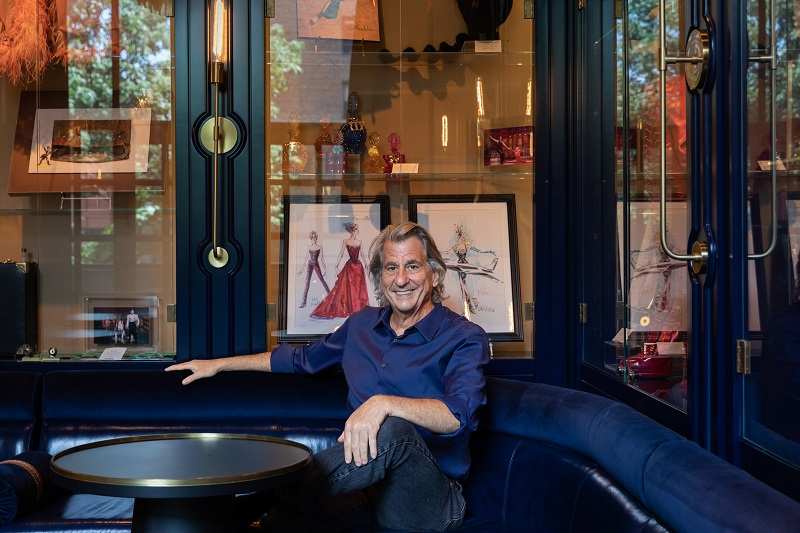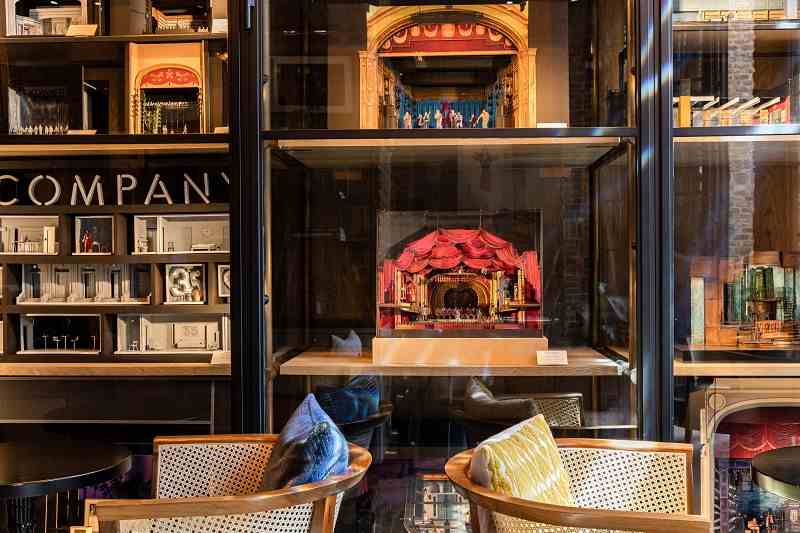
Set (and hotel) designer David Rockwell in the Blue Room of the newly opened Civilian Hotel in New York
12:57 JST, July 23, 2022
NEW YORK – In the stylish Blue Room, you can sip a cosmo while surrounded by display cases containing Evan Hansen’s shirt, King George III’s crown, the knee-high red boots from “Kinky Boots.” In the airy restaurant, you’ll dine under sconces illuminated with etched drawings of the 41 Broadway theaters. Even in the elevators, you’re enclosed by walls covered in the drawings of costumes from “Hamilton,” “Chicago” and “After Midnight.”
All through the hallways and suites and lounges of the Civilian, a new 27-story, 203-room hotel a block from Times Square, guests can face everything about Broadway except the music. (Although one easily imagines a concert or cabaret singer headlining there, too.) It’s a veritable shrine to Broadway design, spearheaded by innovative set designer David Rockwell.
What’s unique about the Civilian – which started receiving guests in November but is still completing some dining spaces – is not that it uses its proximity to Broadway as a thematic springboard. The originality resides in the array of talented artists who’ve been brought in to consult on and contribute to a hostelry that owes almost as much to curation as commercialism. Tony Award-winning set, costume and lighting designers such as Rachel Hauck (“Hadestown”), Christine Jones (“Harry Potter and the Cursed Child”), Paul Tazewell (“Hamilton”), Clint Ramos (“Eclipsed”) and Jules Fisher (“Pippin” and eight others) are among those whom Rockwell (“Hairspray,” “Into the Woods”) recruited for the project.
A hotel and restaurant designer as well – the interior of Danny Meyer’s Union Square Cafe was one of the projects of his firm, the Rockwell Group – Rockwell speaks of the artwork, props and models of sets he has gathered in the Civilian as if he’s the caretaker of an underappreciated legacy. (The building itself is by the New York firm Gwathmey Siegel Kaufman Architects.) “The collection is dedicated to taking a world that’s ephemeral,” Rockwell said, “and giving it a sense of permanence.”
Broadway has venerable watering holes such as Joe Allen, the West 46th Street restaurant adorned with posters from storied flops, and Sardi’s, the historic spot on West 44th festooned with the caricatures of Broadway luminaries. But the Civilian raises the bar for Times Square gathering places bathed in a theatrical aesthetic. An example is its “Company Wall” – an exhibit of paintings and photographs by artists, theater professionals and students that evoke a lyric from Stephen Sondheim’s score for “Company.” “It’s a city of strangers, some come to work, some to play,” begins the inscription, taken from the song “Another Hundred People.”
On the wall above are depictions of New York street scenes as well as more abstract notions of the teeming and isolating qualities of city life. Among them are drawings by Boris Aronson of the set for the original 1970 production of “Company,” a stark cityscape of scaffolding and elevators that is regarded as a giant leap forward for modern set design.

The Cocktail Room features set designers’ models.
“I am completely enchanted by the place,” Christine Jones said by Zoom from Chicago, where she’s fine-tuning the set of the Broadway-bound musical version of “The Devil Wears Prada.” She added that it was particularly touching that work by Tony Walton, the revered Broadway set designer who died in March, appears in the hotel. “It’s really moving to walk upstairs and see his drawings on the wall,” Jones observed. “And for it to happen in a setting that isn’t a museum. It is a place where we will come and we will have drinks after our shows.”
The Civilian, located on West 48th Street between Eighth and Ninth avenues, is a venture by hotelier Jason Pomeranc, who sees it as place in which theater folk and theatergoers can mingle. (Rooms at the Civilian range from $239 to $409 a night on weekends, and weekdays start at $179.) “It’s not just the before- and after-theater dinners, but it’s actually the creatives hanging out there, making it their place and instilling the building with energy,” Pomeranc said.
The theatrical vibe begins streetside, as you gaze up at an arched facade of reclaimed brick – an homage, according to Rockwell, to the exterior of the Al Hirschfeld Theatre (formerly the Martin Beck) three blocks away.
“It’s a hotel that’s about a community,” Rockwell said as he led me on a tour of dining areas, bars, guest rooms – and the objects in what has been termed the Olio Collection. “Community” indeed: The Broadway production of “Take Me Out” held its cast party at the Civilian; singer-comedian Randy Rainbow threw a birthday bash, and to mark the end of his run in the off-Broadway revival of “Little Shop of Horrors,” actor Skylar Astin celebrated there with his co-stars.
The narrow lobby is illuminated by rows of lightbulbs in the ceiling, conveying the sensation of walking under a theater marquee; a bank of wooden seats rescued from an old theater in Buffalo lines a wall across from a reception desk.
Photos hang everywhere: in the restaurant, in the bar, in the guest room corridors, by Broadway photographers including Bruce Glikas and Sara Krulwich, of Audra McDonald, Bette Midler, Barbra Streisand, and on and on. Alan Cumming and Natasha Richardson, stars of a celebrated “Cabaret” revival directed by Sam Mendes in 1998, peer out in one picture; Judy Garland seated in an audience gazes out in another.
Costume designer Clint Ramos stepped out of his comfort zone to participate in the project, drawing three Broadway theaters for the gallery of sconces. “I love his kind of maverick way, his sort of very individual brand of advocacy and activism,” Ramos said of Rockwell. His pencil portraits of the exteriors of two theaters, the Hudson and the Barrymore, and the interior of a third, Circle in the Square, are etched into fixtures alongside those by set designers including Scott Pask, Mimi Lien and Neil Patel. Nearby is the theater that Hauck chose to draw, the Walter Kerr, for the simple reason that her multifaceted, swirling set for “Hadestown” sits on its stage.
“I felt a little intimidated, because of course my primary medium is model, not sketch,” Hauck said. “So I was like, I can do one and it’s this one that means the whole world to me, this theater.”
Rockwell asked Tazewell, Oscar-nominated for his costumes for the film remake of “West Side Story,” to curate with him the items in the glass cases in the Blue Room – a cozy space in medium-dark blue with leather and velvet banquettes and satin finishes, that now is home to pieces of Rafiki’s costume from “The Lion King” and perfume bottles from “She Loves Me.”
“Most people who go to see Broadway shows, they don’t think much about what happens to these pieces after a show has closed or a performer has left a production,” Tazewell said. “It’s like for ‘Hamilton,’ we’ve got a huge warehouse that has all of the clothes from different productions. But then there are those pieces that you really want to hold and raise up.”
Lighting designer Jules Fisher has extensive collections of scenic designs; he loaned to the Civilian three drawings by Walton and two by Aronson. He bemoans the favoring in many design studios these days of the iPad over the drawing table: “There’s no human touch, no human hand,” he said.
Perhaps the Civilian and Rockwell will remind people of the traditions of Broadway design?
“The fact that this hotel is featuring theater craft is unusual,” Fisher said. “David is a persuasive person.”
That persuasiveness extended to the American Theatre Wing, a philanthropic organization that advances theater education (and operates the Tony Awards with the Broadway League). With Rockwell’s encouragement, the Wing became a promotional partner, an arrangement that led to an unusual financial bonus for the nonprofit: With every guest booking of a deluxe room, the Wing receives a small percentage of the revenue.
“It’s a match made in heaven in terms of a partnership,” said Heather Hitchens, the Wing’s president and chief executive.
“These are things that you’re not just going to see anywhere, for people who love the behind the scenes,” she said of the Civilian’s immersion in design. “For somebody who loves the theater, it’s a really unintimidating way to immerse yourself. Because audiences are hungry for more than just going to the show and coming back.”
"News Services" POPULAR ARTICLE
-

American Playwright Jeremy O. Harris Arrested in Japan on Alleged Drug Smuggling
-

Japan’s Nikkei Stock Average as JGB Yields, Yen Rise on Rate-Hike Bets
-

Japan’s Nikkei Stock Average Licks Wounds after Selloff Sparked by BOJ Hike Bets (UPDATE 1)
-

Japanese Bond Yields Zoom, Stocks Slide as Rate Hike Looms
-

Japan’s Nikkei Stock Average Buoyed by Stable Yen; SoftBank’s Slide Caps Gains (UPDATE 1)
JN ACCESS RANKING
-

Keidanren Chairman Yoshinobu Tsutsui Visits Kashiwazaki-Kariwa Nuclear Power Plant; Inspects New Emergency Safety System
-

Imports of Rare Earths from China Facing Delays, May Be Caused by Deterioration of Japan-China Relations
-

University of Tokyo Professor Discusses Japanese Economic Security in Interview Ahead of Forum
-

Japan Pulls out of Vietnam Nuclear Project, Complicating Hanoi’s Power Plans
-

Govt Aims to Expand NISA Program Lineup, Abolish Age Restriction





















